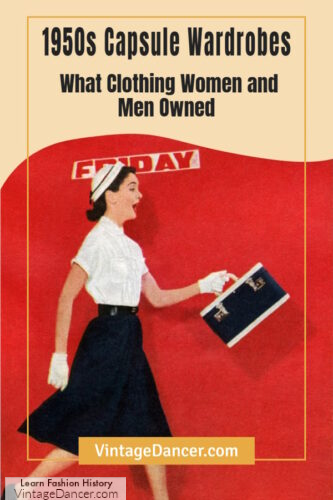
What clothing did a woman own in the 1950s and 1960s? And men too. If I were to create a 1950s capsule wardrobe what should I include?
I set out to answer these questions using real data collected from government surveys and housekeeping textbooks taught to high school girls. Beginning in the 1900s – 1910s, 1920s and 1930s, 1940s and now here the 1950s and 1960s.
The change over the decades was minimal until the 1950s when fast fashion and more middle class income changed the away women and men shopped for clothing.
1950s Capsule Wardrobes
The booming economy of the 1950s, improvements in manufacturing during from the war, an increase in casual fashion, and the new “New Look” silhouette created the first decade where a noticeable increase of clothing was being purchased.
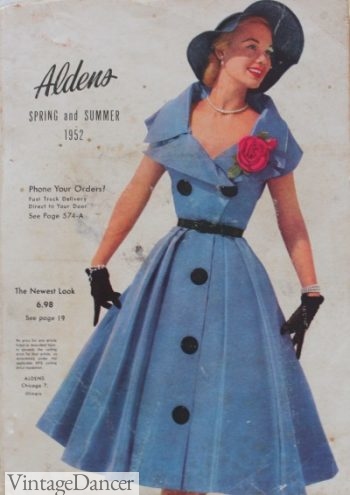
1952 Aldens catalogs had the latest fashions at affordable mass produced prices.
Prices per item were lower, but women were encouraged to buy matching sets. Women were buying more separates and outfits for various occasions and seasons (for colors, not just material). Casual clothing made it to onto the lists for the first time, especially for teens whose wardrobe demands increased dramatically. The lists were growing longer and increasing in quantity.
Clothing had to look New! Fresh! Clean! “Out with the old and in with the new” was happening at much faster rates than the past 40 years. Handmade clothing looked to homey – too war time – to be fashionable in the 1950s. Greater numbers of families moved to the suburbs, where life was more comfortable, bringing with them their father’s city budget which stretched further.
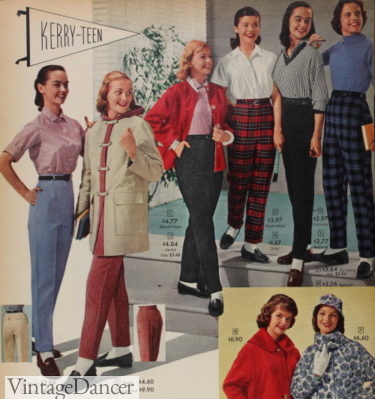
1959, clothes for teen girls
1955 Young Woman/Teen in middle class (lives in colder climate):
*follow the links to learn about each clothing item
- Coats – 1 lightweight, 1 winter, 1 raincoat, 1 jacket, 1 blazer.
- Dresses – 3 wool, 3 cotton, 1 formal dress, 1 rayon afternoon dress, 1 dressy cotton, 1 party/dance dress, and optional tennis dress.
- Skirts – 2 wool, 1 cotton.
- Suits – 1.
- Blouses 3 (2 day, 1 fancy)
- Sweater – 2 pullovers, 1 cardigan.
- Denim pants – 1.
- Denim shorts – 2.
- T-shirts – 2.
- Swimsuits – 1.
- Hosiery – 2 daywear, 2 evening, 6 socks, 2 tall winter socks.
- Shoes – 2 pairs low heel/loafer/Oxford, 1 dance heel, 1 casual shoe, 1 tennis shoe, 1 slipper, 1 rain boots, 1 snow boots.
- Hats – 1 felt hat, 1 beret hat, 1 wool kerchief, 1 straw hat, 1 cotton kerchief.
- Gloves – 2-4 spring and winter gloves.
- Bags – 1- 3 for day and evening.
- Scarves – 1 sheer dressy scarf, 1 winter scarf.
- Robes – 1 cotton, 1 flannel.
- Pajamas – 2 winter, 2 summer.
- Underwear – 2 slips, 6 panties, 3 brassiere, 1 girdle, 1 garter belt.
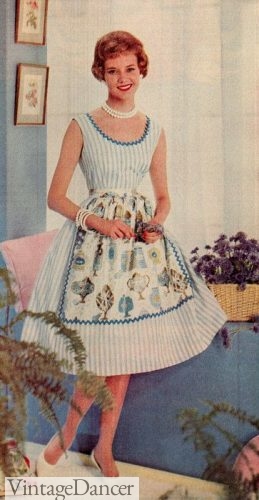
Perfect housewife uniform- dress + apron
1956 Housewife Clothing:
- Coats – 1 winter longcoat, 1-2 spring coat/cape/short jacket, 1 fur coat.
- Jackets – 1 heavy jacket or leather jacket (optional).
- Dresses – 5 house dresses, 6 afternoon and evening dresses.
- Suits – 1-2.
- Skirts – 1-2.
- Blouses and shirts – 4-5.
- Sweaters – 1 pullover, 1 cardigan.
- Aprons – 6, a mix of plastic and cotton.
- Pants – 1 cotton, 1 pair jeans or overalls.
- Shorts – 1 pair shorts or play-suit.
- Swimsuit – 1.
- Underwear – 5 slips and petticoats, 7 panties.
- Lingerie – 4 brassiere, 1-2 corsets or girdles.
- Pajamas – 1 pair, 3 nightgowns.
- Robes – 2.
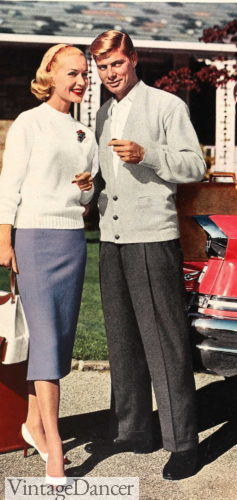
1958 her: pencil skirt and sweater him: trousers and cardigan
1956 Men’s Clothing (middle class):
- Coats – 1 winter overcoat, 1 raincoat, 1 other coat.
- Jackets – 1 Mackinaw jacket/peacoat/parka, 1 light jacket.
- Hats – 1 felt, 1 straw, 1 winter cap, 1 casual hat.
- Suits – 2-3 winter or year-round suits, 1 summer suit, 1 optional tuxedo or dressy suit.
- Sport coats – 1.
- Pants – 2-3 extra dress pants.
- Work Clothes (if applicable) – 2 work pants, 1 overall, 1 shop coat/work jacket, 1 apron, 3 work shirts, 4 heavy work socks, 1 boots, 1-2 gloves.
- Swim Shorts – 1.
- Shirts – 4 knit T-shirts/polo shirts, 3-5 button down sport shirts, 4-9 dress shirts.
- Sweater – 1-2 pullovers, 1 cardigan.
- Underwear – 3 briefs or shorts, 4-5 undershirts, 2 union suits.
- Pajamas – 2-3, 1 robe.
- Socks – 13.
- Shoes – 1-3 day shoes, 1 -2 rubber boots/snow boots, 1 slippers, 1 sneaker/sport shoes.
- Handkerchiefs – 20.
- Gloves – 1-2 pairs.
- Scarves – 1-2.
- Ties – 18.
- Misc – belts, jewelry, watches, suspenders, sock garters- as needed, usually at least 1 of everything
- Source.
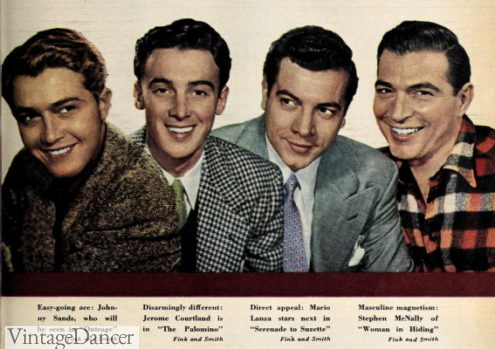
1950s leading men of Hollywood
1960s Capsule Wardrobes
Statistics on family clothing expenditures diminished in the 1960s. The “buy everything new” attitude from the 1950s carried over and only increased in the space age. Fast fashion was becoming the new norm as middle class families purchased new clothing every season, discarded old ones before they were worn-out, and purchased more often out of desire instead of necessity.
Low income girls purchased 6-12 new dresses a year. The average number for middle classes were 14-20 dresses. Mothers purchased a few less than teens. A few wealthier teens said they purchased over 40 dresses a year!
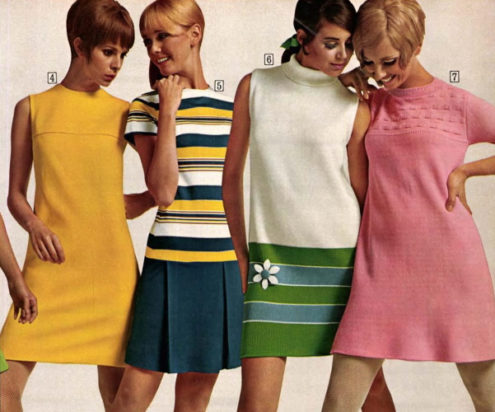
1968 knit shift dresses for teens
1963 Teenage Girl:
- Coats – 1 winter, 1 spring.
- Suits – 1-2.
- Pants -1-2
- Tops and -4-6
- Skirts – 2-3
- Dresses – 2-4 Cotton, 1 jumper, 1 three-quarter sleeve afternoon dress, 1 party dress.
- Hats – 2-4 or veils/hair accessories.
- Gloves – 2-4 short and long.
- Shoes – 4-6 heels, flats, casual, sandals, booties.
- Purses – 2 for spring and winter, 1 for evenings.
- Lingerie – 3-5 sets.
- Sleepwear – 1-3
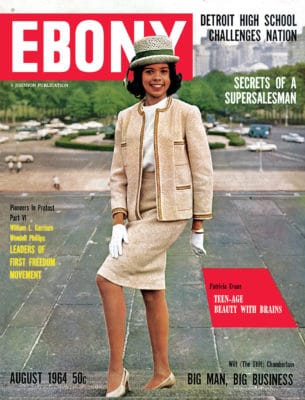
1964 Ebony
1961 plan for a self supporting woman:
- Coats – 1 heavy coat, 1 light coat and 1 raincoat, purchased every 2 years. 1 housecoat purchased every 2 years.
- Hats – 1 felt, 1 straw, purchased yearly.
- Suits, wool – 1 purchased every 2 years.
- Skirts, wool – 1 purchased every year.
- Jeans – 1 purchased every 3 years.
- Sweaters and cardigans – 1 purchased every 3 years.
- Blouses – 3 purchased yearly.
- Dresses – 2 wool yearly, 2 street dresses yearly, 2 cotton daywear dresses per year, 1 afternoon/fancy dress per year.
- Bathrobes – 1 purchased every 2 years.
- Nightgowns – 3 total for summer and winter purchased yearly.
- Underwear – 2 slips per year, 4 panties per year.
- Lingerie – 3 girdles per year, 3 brassiere per year.
- Stockings – 24 nylon daywear per year, 3 dressier pairs per year.
- Socks – 2 per year.
- Shoes – 2 work pairs, 1 dress pair, 1 casual pair every two years, 1 pair slippers every 3 years, 1 pair rain shoes every 3 years.
- Gloves – 2 per year.
- Bathing Suits – 1 every 4 years.
- Handbags – 1-2 per year, seasonal.
From here on out, clothing purchases only grew more and more. Wardrobes expanded at record rates. What surprised you the most about the clothing people bought in the 1950s and 1960s?
Other Decades
1910s Capsule Wardrobe & What Clothing Cost
1920s & 1930s Vintage Capsule Wardrobes
1940s Capsule Wardrobe & What Clothing Cost
Debbie Sessions has been teaching fashion history and helping people dress for vintage themed events since 2009. She has turned a hobby into VintageDancer.com with hundreds of well researched articles and hand picked links to vintage inspired clothing online. She aims to make dressing accurately (or not) an affordable option for all. Oh, and she dances too.